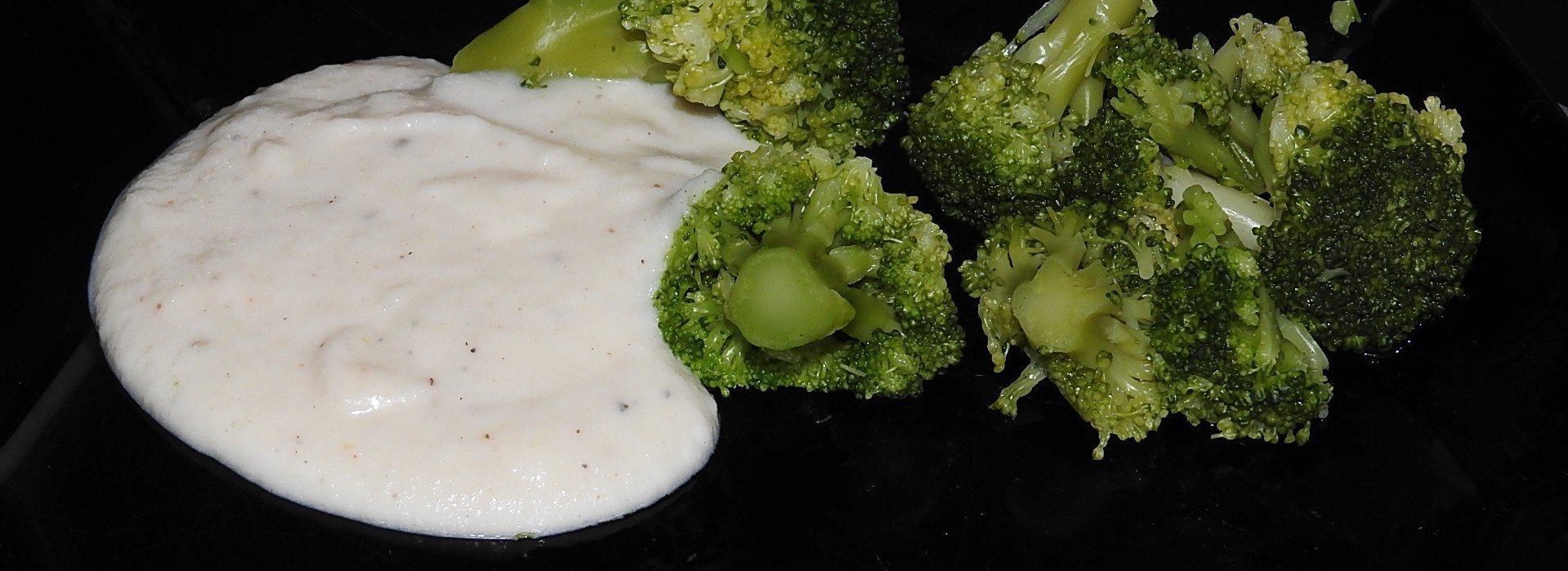starch-thickened sauces - intro
These are sauces that are thickened with starches, regardless when that happens during the cooking process. These are also emulsions, but the emulsifying agents here are starches..
A. Roux-based sauces
A roux is fat and flour cooked together. It is the base for three of the five ‘mother’ sauces in the French cuisine: béchamel, velouté and Espagnole. In English: white, blond and dark sauces.
All are made in a very similar way.
- Béchamel uses a white roux and milk (or cream / cheese as milk alternatives.)
- Velouté uses a blond roux and a light stock.
- Espagnole uses a very dark roux and fortified stock = stock made with roasted bones.
1. Béchamel and derived Sauces
 Pic1: creamed cauliflower sauce
Pic1: creamed cauliflower sauce
Dishes made with béchamel sauce include:
- cauliflower cheese
- fisherman's pie
- lasagne
- parmo
- moussaka
- pastitsio
- veal Orlov
Béchamel sauce is the base for a number of other classic sauces, including:
- Mornay sauce (cheese and egg yolk)
- Nantua sauce (crawfish, butter and cream)
- crème sauce (heavy cream)
- mustard sauce (prepared mustard seed)
- cheddar cheese sauce (cheddar cheese, dry mustard, Worcestershire sauce)
- soubise sauce (finely diced onions that have been sweated in butter)
2. Velouté and derived Sauces
A velouté or blond sauce is often served on poultry or seafood dishes. Velouté comes in different colors, depending on the broth used and other added ingredients.
 Pic2-3: three different colored velouté sauces
Pic2-3: three different colored velouté saucesinternet pictures
Sauces derived from a velouté sauce include:
- Allemande a.k.a. Parisienne sauce:
- a veal velouté with a few drops of lemon juice, egg yolk and cream liaison.
- used to top cold asparagus, also used with poultry and some fish dishes.
- Aurore:
- add tomato purée.
- Curry Sauce
- a chicken or fish velouté with curry powder, garlic, thyme bay leaf and parsley stems thickened with cream.
- used with fish, shellfish and a few chicken dishes.
- Wine sauce:
- such as white wine sauce and champagne sauce.
3. Espagnole and derived Sauces
Espagnole aka dark or brown sauce has a strong flavor.
It is supposed to be made by reducing a dark roux and a strong stock from roasted bones.
Be warned: I don't make espagnole or demi-glace, EVER.
I consider it a waste of my time. My brown sauces are already savory enough that I do not feel the need to concentrate them. I have never roasted bones and boiled them to darken a stock. I take a shortcut here and work with the sauce I already have.
In my recipes, dark sauces are the result of making pot roasts or stews. Those are sauces that I like to soak my fries in. They are more than dark and savory enough for my daily kitchen that I don't need or even would want to spend hours concentrating them further, meaning that my dark sauces are prepared as a direct velouté instead of through demi-glace.
 Pic5: dark sauce
Pic5: dark sauceinternet picture
A few of many of derived sauces:
- Sauce Africaine
- Sauce Bourguignonne
- Sauce aux Champignons
- Sauce charcutière
- Sauce Chasseur
- Sauce Chevreuil
B. non-roux starch-thickened sauces
A lot of popular sauces are derived from these three roux-based mother sauces: you make a roux first and then add additional ingredients that make the intended sauce.
Flour can also be dissolved in liquid or oil and that mixture can be added later in the process to thicken the sauce. That happens a lot when the sauce is made in the cooking pot with the meat, seafood or vegetables still present. Strictly spoken, those are not roux sauces, but I categorize them together with roux sauces regardless of when the starches are added during the cooking process.
C. categorization problems
There is definitely overlapping and confusion about the categorization of these sauces.
- Curry sauce is listed both as velouté and béchamel-derived.
- Mushroom sauce is listed as derived from both veloute and demi-glace.
- etc.
That is not so surprising. The only difference between béchamel and velouté is milk vs. some other liquid. Espagnole is imo a totally useless sauce that I gladly forego. When you consider milk as just one of many possible stocks, or when you start mixing milk or cream with other stocks, the 3 roux-based groups merge into a single one.
The use of starches to thicken the sauce is the one common and defining ingredient in this group of sauces. Even though the timing starches are added (roux vs. later,) results in slightly different textures, the outcome is essentially the same. For that reason, I gathered all starch-thickened sauces in a single group.
I maintained the classic division—white, blond and dark—for easier reference, but I don't make that distinction in my kitchen. All these sauces can be and are prepared with the same general method and none of them tastes any worse for it.
It may be obvious that many of my sauces were prepared 'the right way' according to French cuisine.
- I don't have the time or inclination to spend hours reducing a stock just to make a sauce by the book. So I don't. I take shortcuts to get it done within the time constraints of a life with other things to do besides cooking.
- I have no reservations about adding dairy products to velouté or brown sauces.
- I don't always use milk alone for supposed béchamel sauces. I often add meats, seafood and/or vegetables.
- These practices erase the distinction between those 3 groups.
As always, my response to criticism in this context is that I couldn't care less. As long as it tastes good, I'm OK with it, no matter how I got there. When a classification system is restricts the possibilities and convenience of day-to-day cooking, it is obsolete and needs to be updated.